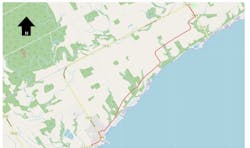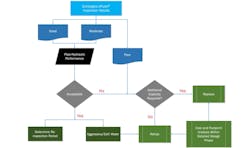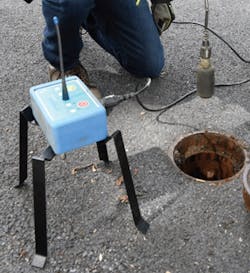Acoustic Pipe Condition Assessment in Canada
About the author:
Alain Lalonde, P.E.., is regional manager of Echologics for Mueller Canada. Lalonde can be reached at [email protected].
Norfolk County, a municipality in Ontario, Canada, was incorporated as a city in 2001 and has a population of more than 60,000 residents. Norfolk is located 56 km (35 miles) southwest of Hamilton and 97 km (60 miles) southeast of London.
The county recently encountered a main break on its 12 inch ductile iron transmission water main, which is the only feed from the community of Port Rowan to the community of St. Williams, meaning the impact to residents was significant. The team suspected that the leak on this line was caused by pitting corrosion, a common cause of failure in ductile iron pipes. During the repair, the water operations staff noted that there was significant deterioration and corrosion to the bottom section of the ductile iron water main.
“Norfolk County has other communities that are fed from well sites via these transmission mains. These sites are also vulnerable because of the single feed and lack of redundancy,” said Jeff Demeulemeester, certified engineering technologist and project manager for Norfolk County.
Capital Planning & Project Prioritization
Norfolk’s 10-year capital plan is an integral component of its long-term financial sustainability program and underscores the importance of ensuring projects are prioritized, substantiated and affordable. It was imperative to understand the existing condition of its water mains to ensure effective preventative maintenance.
The county put out a request for proposal for condition assessment of its watermains. After rounds of trials and deliberation, Echologics ePulse non-invasive condition assessment technology by Mueller was selected to determine the existing structural condition and locate any existing leaks and anomalies.
For this project, Echologics tested approximately 6.9 km (4.3 miles) of the ductile iron transmission main running primarily along Front Road. Norfolk selected this section of pipe due to its lack of redundancy and previous break history. Since a failure on this line could also have a large impact on Norfolk’s residents, a condition assessment survey was performed to determine if any areas along the line had experienced significant degradation. Based on the findings, the engineering firm AECOM recommended next steps of pipeline renewal options, if needed.
How the Acoustic Condition Assessment Technology Works
The ePulse technology was implemented by attaching two acoustic sensors, each to an existing contact point, such as a fire hydrant, valve or directly in contact with the pipe wall. A sound wave was induced in the pipeline and its propagation speed was measured between the two acoustic sensors.
The speed at which the sound wave traveled was dictated by the condition of the pipe wall. After field work was completed, the speed of sound was combined with other information collected onsite, including distance and water temperature, and then using proprietary advanced algorithms, the technology determined the average wall thickness remaining for each segment.
These results were interpreted in the form of three categories, “good”, “moderate”, and “poor”. A wall loss percentage that was less than 10%, was denoted as good; a wall loss percentage from 10% to 30% was denoted as moderate; and a percentage that was larger than 30% was classified as “poor”.
“Each ePulse result represented an average condition within a segment between two sensor attachment points,” said Khalid Kaddoura, project manager for AECOM. “Often, when planning a replacement program, asset managers are looking for an overall score representative of pipe condition to rank pipe for replacement. ePulse results are great for this purpose.”
Acoustic Condition Assessment Becomes Acoustic Leak Detection
The second part of the project required an investigation for leaks and anomalies, which was simultaneously fulfilled during the condition assessment. This is the advantage of deploying ePulse as both assessment and leak detection could be performed at the same time with the same acoustic correlator.
After a 12-day assessment period, ePulse results indicated that 12 of the 54 segments were in poor condition with an average wall thickness loss greater than 30%. Additionally, 30 segments appeared to be in moderate condition with 10% to 30% loss in original wall thickness. Another 11 segments appeared to be in good condition with less than a 10% loss in original wall thickness, and the remaining one segment could not be assigned a result.
No leaks were detected during the time of the survey. However, a point of interest (POI) was identified. POI designation indicated that some, but not all, of the criteria for a positive leak detection result were met. A secondary investigation later confirmed that the leak noise originated from a normal functioning pressure reducing valve within a meter pit.
“We are pleased that the project provided the data we required to prioritize and make an educated schedule for replacement based on the watermain’s remaining wall thickness,” Demeulemeester said. “Furthermore, the cost of the assessment was considered minor as it provided Norfolk County with the required data to prioritize the replacement of our transmission main network over the 10-year capital plan. Based on a ‘worst first’ replacement schedule, we were able to align the timing with our required financial planning.”
Bring it All Into Focus
Based on the results collected by the Echologics field team, AECOM developed a customized renewal decision tree along with budgetary cost estimates of some renewal options. Incorporating ePulse inspection results, the decision tree was based on the three condition categories: good, moderate, and poor.
For the first two categories of good and moderate, the watermain’s hydraulic performance was recommended to be assessed. If it fell within the acceptable range, additional assessment would be performed to check the water characteristics. A rehabilitation intervention was recommended if the water quality did not comply with the local standards.
On the other hand, if the watermain’s hydraulic performance was unacceptable or was determined to be in the poor condition category, a replacement was recommended should larger hydraulic capacity be required. If the hydraulic capacity was sufficient, renewal techniques were considered on a case by case basis, depending on cost and construction footprint analysis.
Following the project completion, Norfolk County scheduled the replacement of pipe sections with poor condition, with more sections identified to be replaced in its 10-year Capital Plan.


